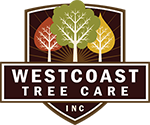Trees are amazing organisms that add warmth and beauty to our landscapes. Not only do they clean the air and produce half the world’s oxygen, they also provide habitat for millions of species. Trees are also known to withstand hurricane force winds, freezing temperatures, and prolonged droughts. As tough as they are, however, even the slightest change can affect them.
When a tree is affected by certain ailments like disease, injury, or damage, it can become a serious hazard to nearby people, homes, property and cars. That’s why it’s important to practice preventative tree care by examining your trees often and keeping an eye out for signs that may indicate a hazardous tree.
Hazardous Tree Indications
There are several common warning signs that may indicate an unhealthy, damaged, and hazardous tree. While some things are easier to spot than others, a hazardous tree will show one or more of the following signs:
Deadwood
Broken branches or sections of a tree that are dead are considered deadwood. Deadwood is considered hazardous because it can become dislodged at any time due the natural elements. Deadwood can also fall unexpectedly and cause extensive harm or damage to whatever it falls on.
That’s why it’s extremely important to have deadwood professionally trimmed and removed by a certified arborist as soon as possible to prevent dangerous situations from happening.
Cracks & Cankers
While certain trees like the Douglas Fir develop cracks naturally, cracks in other species may indicate a hazardous tree. Depending on how large a tree is or how serious a crack is, corrective measures like cabling may reduce the likelihood of structural failure. However, hazardous cracks that extend deep or completely through the trunk may result in the removal of the entire tree.
Cankers, on the other hand, are open sores or dead areas located on the outside of a tree. While cankers may not be enough to warrant the removal of an entire tree, it’s important to have a preventative tree care inspection done by a certified arborist. Cankers that take up more than half a tree’s circumference may indicate a hazardous tree.
Weak Branch Unions
Weak branch unions are places where branches are not strongly attached to a tree. They can occur naturally or due to improper pruning techniques. Easily identifiable, a weak branch union can be spotted when bark grows between two close branches and inside of the union. This deformity can be especially dangerous when a weak union leads to a crack between two main branches.
Decay
Rot and decay that feels spongy, or crumbly to the touch can indicate a hazardous tree. Other signs include growing cavities, fungi, and an exposed root system. While decay may not automatically render a tree unsafe, it’s important to have a preventative tree care inspection done by a certified arborist to make sure it is relatively healthy and safe from failure.
Root Damage
While it may be difficult to detect a failing root system, there are certain signs to look out for that may indicate a hazardous tree. These include mounds or bulging in the soil around the base of the tree, visible dead roots, a decline in the tree canopy, and an increased lean in the tree. Excavation, soil compaction, trenching, paving, environmental stress and fungal decay are all causes of root damage. Since assessing a damaged root system can be difficult, it’s important to have a tree inspected by a certified arborist if you suspect your tree may affected.
Preventative Tree Care
It’s important to pay attention to any indications of a hazardous tree. Keep in mind that many signs are often subtle or even undetectable to the untrained eye. If you suspect your tree may be diseased, damaged or dying, contact Westcoast Tree Care at 1.800.767.8733. Our certified arborist can help diagnose a variety of tree care problems and answer any questions you may have. We will also provide you with a no-cost, no-obligation quote for any of our preventative tree care services.








